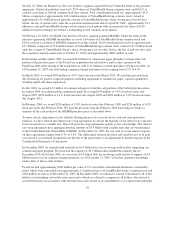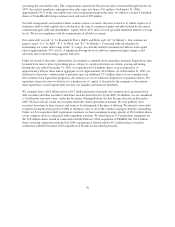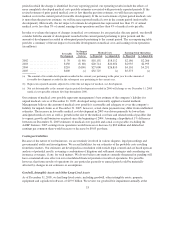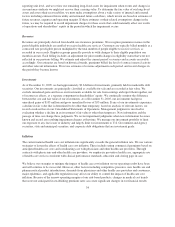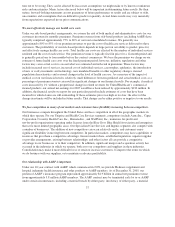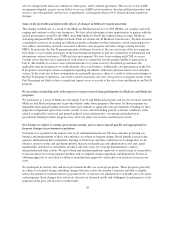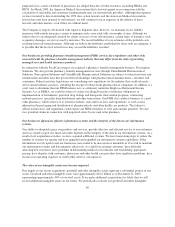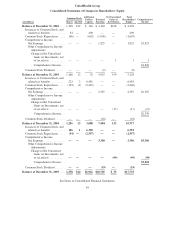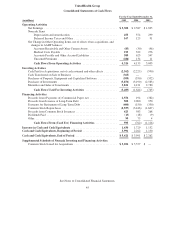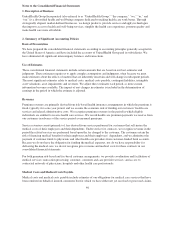United Healthcare 2005 Annual Report Download - page 39
Download and view the complete annual report
Please find page 39 of the 2005 United Healthcare annual report below. You can navigate through the pages in the report by either clicking on the pages listed below, or by using the keyword search tool below to find specific information within the annual report.turn out to be wrong. They can be affected by inaccurate assumptions we might make or by known or unknown
risks and uncertainties. Many factors discussed below will be important in determining future results. By their
nature, forward-looking statements are not guarantees of future performance or results and are subject to risks,
uncertainties and assumptions that are difficult to predict or quantify. Actual future results may vary materially
from expectations expressed in our prior communications.
We must effectively manage our health care costs.
Under our risk-based product arrangements, we assume the risk of both medical and administrative costs for our
customers in return for monthly premiums. Premium revenues from risk-based products (excluding AARP) have
typically comprised approximately 75% to 80% of our total consolidated revenues. We generally use
approximately 80% to 85% of our premium revenues to pay the costs of health care services delivered to these
customers. The profitability of our risk-based products depends in large part on our ability to predict, price for,
and effectively manage health care costs. Total health care costs are affected by the number of individual services
rendered and the cost of each service. Our premium revenue is typically fixed in price for a 12-month period and
is generally priced one to four months before the contract commences. We base the premiums we charge on our
estimate of future health care costs over the fixed premium period; however, inflation, regulations and other
factors may cause actual costs to exceed what was estimated and reflected in premiums. These factors may
include increased use of services, increased cost of individual services, catastrophes, epidemics, the introduction
of new or costly treatments and technology, new mandated benefits or other regulatory changes, insured
population characteristics and seasonal changes in the level of health care use. As a measure of the impact of
medical cost on our financial results, relatively small differences between predicted and actual medical costs as a
percentage of premium revenues can result in significant changes in our financial results. For example, if medical
costs increased by 1% without a proportional change in related revenues for UnitedHealthcare’s commercial
insured products, our annual net earnings for 2005 would have been reduced by approximately $130 million. In
addition, the financial results we report for any particular period include estimates of costs that have been
incurred for which claims are still outstanding. If these estimates prove too high or too low, the effect of the
change in estimate will be included in future results. That change can be either positive or negative to our results.
We face competition in many of our markets and customers have flexibility in moving between competitors.
Our businesses compete throughout the United States and face competition in all of the geographic markets in
which they operate. For our Uniprise and Health Care Services segments, competitors include Aetna Inc., Cigna
Corporation, Coventry Health Care, Inc., Humana Inc., and WellPoint, Inc., numerous for-profit and
not-for-profit organizations operating under licenses from the Blue Cross Blue Shield Association and enterprises
that serve more limited geographic areas. Our Specialized Care Services and Ingenix segments also compete with
a number of businesses. The addition of new competitors can occur relatively easily, and customers enjoy
significant flexibility in moving between competitors. In particular markets, competitors may have capabilities or
resources that give them a competitive advantage. Greater market share, established reputation, superior supplier
or provider arrangements, existing business relationships, and other factors all can provide a competitive
advantage to our businesses or to their competitors. In addition, significant merger and acquisition activity has
occurred in the industries in which we operate, both as to our competitors and suppliers in these industries.
Consolidation may make it more difficult for us to retain or increase customers, to improve the terms on which
we do business with our suppliers, or to maintain or advance profitability.
Our relationship with AARP is important.
Under our 10-year contract with AARP, which commenced in 1998, we provide Medicare supplement and
hospital indemnity health insurance and other products to AARP members. As of December 31, 2005, our
portion of AARP’s insurance program represented approximately $4.9 billion in annual net premium revenue
from approximately 3.8 million AARP members. The AARP contract may be terminated early by us or AARP
under certain circumstances, including a material breach by either party, insolvency of either party, a material
37




